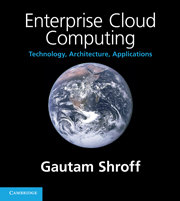Book contents
- Frontmatter
- Contents
- Preface
- List of abbreviations
- Part I Computing platforms
- Part II Cloud platforms
- Part III Cloud technologies
- Chapter 7 Web services, AJAX and mashups
- Chapter 8 Virtualization technology
- Chapter 9 Multi-tenant software
- Part IV Cloud development
- Part V Software architecture
- Part VI Enterprise cloud computing
- References
- Index
Chapter 8 - Virtualization technology
Published online by Cambridge University Press: 06 December 2010
- Frontmatter
- Contents
- Preface
- List of abbreviations
- Part I Computing platforms
- Part II Cloud platforms
- Part III Cloud technologies
- Chapter 7 Web services, AJAX and mashups
- Chapter 8 Virtualization technology
- Chapter 9 Multi-tenant software
- Part IV Cloud development
- Part V Software architecture
- Part VI Enterprise cloud computing
- References
- Index
Summary
If one had to choose a single technology that has been most influential in enabling the cloud computing paradigm, it would have to be virtualization. As we have seen earlier in Chapter 1, virtualization is not new, and dates back to the early mainframes as a means of sharing computing resources amongst users. Today, besides underpinning cloud computing platforms, virtualization is revolutionizing the way enterprise data centers are built and managed, paving the way for enterprises to deploy ‘private cloud’ infrastructure within their data centers.
VIRTUAL MACHINE TECHNOLOGY
We begin with an overview of virtual machine technology: In general, any means by which many different users are able simultaneously to interact with a computing system while each perceiving that they have an entire ‘virtual machine’ to themselves, is a form of virtualization. In this general sense, a traditional multiprogramming operating system, such as Linux, is also a form of virtualization, since it allows each user process to access system resources oblivious of other processes. The abstraction provided to each process is the set of OS system calls and any hardware instructions accessible to userlevel processes. Extensions, such as ‘user mode Linux’ offer a more complete virtual abstraction where each user is not even aware of other user's processes, and can login as an administrator, i.e. ‘root,’ to their own seemingly private operating system.
- Type
- Chapter
- Information
- Enterprise Cloud ComputingTechnology, Architecture, Applications, pp. 89 - 103Publisher: Cambridge University PressPrint publication year: 2010



